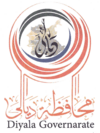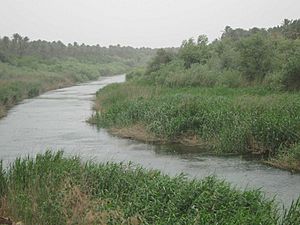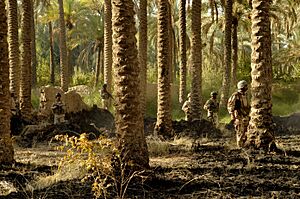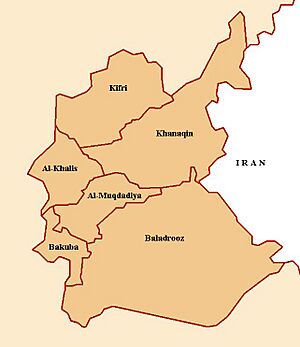Diyala Governorate facts for kids
Quick facts for kids
Diyala Governorate
محافظة ديالى
|
|||
|---|---|---|---|
|
|||
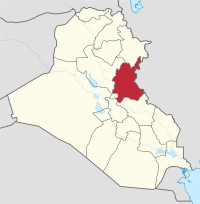 |
|||
| Country | |||
| Capital | Baqubah | ||
| Governor | Muthanna Al-Tamimi | ||
| Area | |||
| • Total | 17,685 km2 (6,828 sq mi) | ||
| Population
(2018)
|
|||
| • Total | 1,637,226 | ||
| ISO 3166 code | IQ-DI | ||
| HDI (2017) | 0.672 medium |
||
Diyala Governorate (Arabic: محافظة ديالى Muḥāfaẓat Diyālā), also known as Diyala Province, is a region in northeastern Iraq. It is one of the many governorates (like states or provinces) that make up the country.
Contents
About Diyala Governorate
Diyala Governorate is located northeast of Baghdad, Iraq's capital. It stretches all the way to the border with Iran. The main city and capital of Diyala is Baqubah. The total area of the governorate is about 17,685 square kilometers (6,828 square miles).
The Diyala River
A big part of Diyala is watered by the Diyala River. This river is a major branch of the Tigris River. Because there is so much water, farming is the main activity here.
Farmers in Diyala grow lots of dates. They also have one of the biggest olive farms in the Middle East. Diyala is even known as the "orange capital" of the Middle East! The Hamrin Mountains also run through this area.
Who Lives in Diyala?
Diyala is home to many different groups of people. You'll find Arabs, Kurds, and Turkmens living together. The latest numbers show that about 1.6 million people live in Diyala.
How Diyala is Governed
The governorate has its own government to manage local affairs.
- The main leader is the Governor, currently Muthanna al-Tamimi.
- There is also a Deputy Governor, Mohammed Jassim al-Jubouri.
- A special council helps make decisions for the region.
Diyala's Districts
Diyala Governorate is divided into six smaller areas called districts. These districts help manage local services and communities.
Here are the districts with their sizes and populations from 2003:
| District | Name in Arabic |
Area in sq. km |
Population in 2003 |
|---|---|---|---|
| Ba'quba | بعقوبة | 1,630 | 467,895 |
| Al-Muqdadiya | المقدادية | 1,033 | 198,583 |
| Khanaqin | خانقين | 3,512 | 160,379 |
| Al-Khalis | الخالص | 2,994 | 255,889 |
| Kifri | كفري | 1,139 | 42,010 |
| Balad Ruz | بلد روز | 6,280 | 99,601 |
| Total | 17,685 | 1,224,358 |
Cities and Towns in Diyala
Diyala Governorate has many cities, towns, and villages. Here are some of the main ones:
- Baqubah (the capital city)
- Nahrawan
- Miqdadiyah
- Hibhib
- Khanaqin
- Balad Ruz
- Al Khalis
- Bani Sa'ad
- Jalawla (or Jalula)
- Al-Sadiyah
- Camp Ashraf
- Dwelah
- Kingirban
- Abd Allah Bayk
- Safra'
- Marfu Village
- Village of Nye
- Udame
- Al Mansouryah
- Kan’aan
- Al Wajehiya
- Al Muntheriya
- Abu Saydah
- Buhriz
- Mandali
- Qaryat Imam ʽAskar
- Kifri
- Qara Tapa
Important Buildings and Services
Diyala Province has an important building called the Diyala Media Center. It has one of the tallest radio and television antennas in the Middle East! This center helps broadcast local news and shows. It also shares state-run television programs. It was built in 1989 by a Japanese company.
History of Challenges and Stability
Diyala has faced some challenges in its recent history. In the mid-2000s, there were periods of instability. Some armed groups were active in the area. This led to efforts by Iraqi and international forces to bring peace.
By 2008, things started to improve. More Iraqi and U.S. forces worked together. They helped reduce the activity of armed groups. Local programs also helped make the area safer.
In 2011, the local council in Diyala wanted more control over their region. They wanted to become a semi-independent area within Iraq. This idea caused some discussions and protests. This is because Diyala has many different ethnic and religious groups.
See also
 In Spanish: Gobernación de Diala para niños
In Spanish: Gobernación de Diala para niños
- Hisham al-Hayali, a former governor of Diyala
- Battle of Baqubah
- 2004 Baqubah bombing
- 15 July 2008 Baquba bombings
- 15 September 2008 Balad Ruz bombing
- 3 March 2010 Baqubah bombings
- 2014 Musab bin Omair mosque massacre



